
Анатомия бега (2010,иностр
.).pdf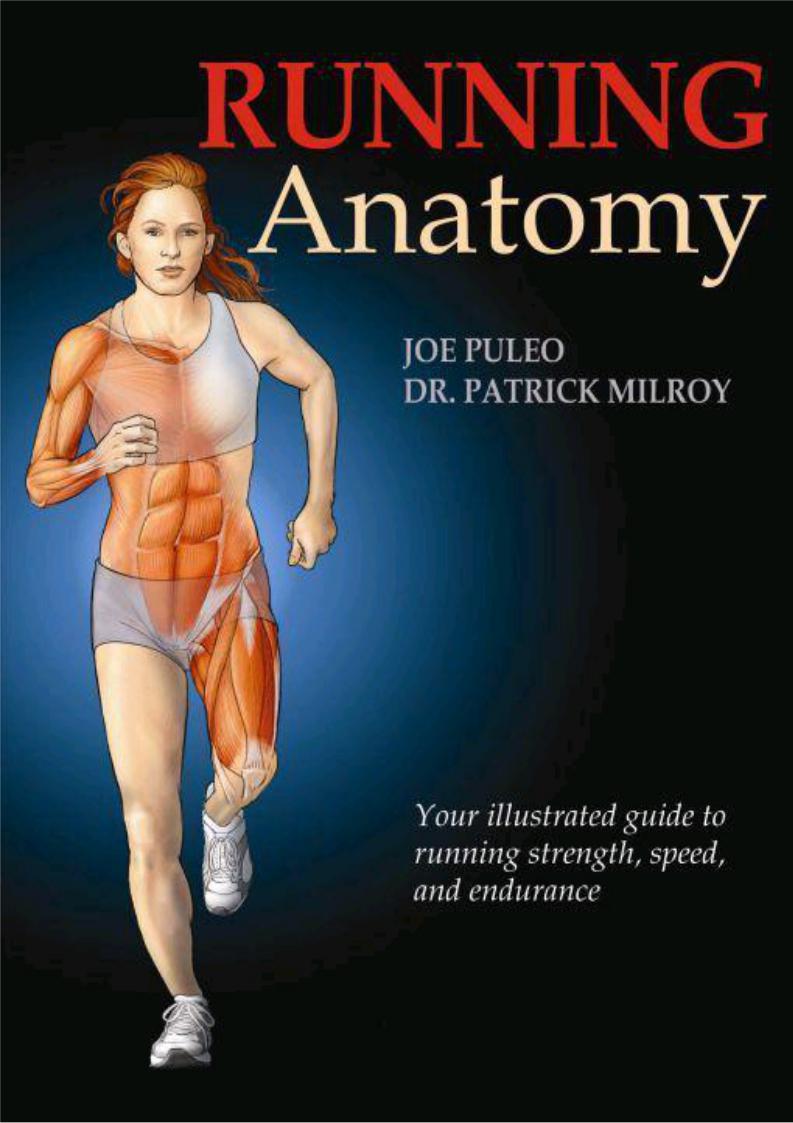
Table of Contents
Title Page
Copyright Page
PREFACE
Acknowledgements
CHAPTER 1 - THE EVOLUTION OF THE HUMAN RUNNER
Evolution of Running
Physiology of Runners
The Future of Running
CHAPTER 2 - CARDIOVASCULAR AND CARDIORESPIRATORY COMPONENTS
Cardiovascular and Cardiorespiratory Systems
Performance Training Progression
CHAPTER 3 - THE RUNNER IN MOTION
Running Gait Cycle
ABC Running Drills
CHAPTER 4 - ADAPTATIONS FOR FOR SPEED AND TERRAIN
Event-Specific Body Characteristics
Effects of Terrain and Other External Factors
CHAPTER 5 - UPPER TORSO
Choosing Resistance
Repetitions
Breathing
Schedule
CHAPTER 6 - ARMS AND SHOULDERS
Specific Training Guidelines
CHAPTER 7 - CORE
Specific Training Guidelines
CHAPTER 8 - UPPER LEGS
Specific Training Guidelines
CHAPTER 9 - LOWER LEGS AND FEET
Specific Training Guidelines
CHAPTER 10 - COMMON RUNNING INJURIES
Specific Training Guidelines
CHAPTER 11 - ANATOMY OF RUNNING FOOTWEAR
Why Wear Running Shoes?
History of 20th-Century Running Shoes
Components of Running Shoes
Barefoot Running
Summary
CHAPTER 12 - FULL-BODY CONDITIONING
Water Running
Plyometrics
EXERCISE FINDER ABOUT THE AUTHORS
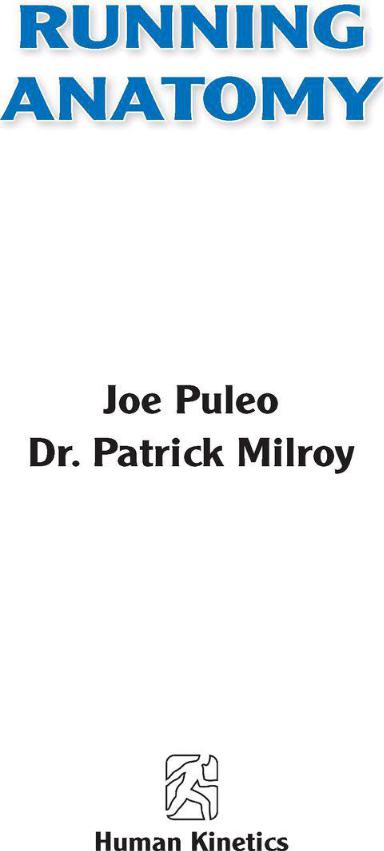
Libraryof Congress Cataloging-in-Publication Data
Puleo, Joe.
Running anatomy/ Joe Puleo, Patrick Milroy. p. cm.
ISBN-13: 978-0-7360-8230-3 (soft cover) ISBN-10: 978-0-736-09183-1 (soft cover)
1. Running--Training. 2. Running--Physiological aspects. 3. Running injuries--Prevention. 4. Sports medicine. I. Milroy, Patrick. II.Title. GV1061.5.P85 2010
796.42--dc22
2009035764
ISBN-10: 978-0-736-09183-1 (print)
ISBN-13: 978-0-7360-8230-3 (print) Copyright © 2010 byJoe Puleo and Patrick Milroy
All rights reserved. Except for use in a review, the reproduction or utilization of this work in anyform or byanyelectronic, mechanical, or other means, now known or hereafter invented, including xerography, photocopying, and recording, and in anyinformation storage and retrieval system, is forbidden without the written permission of the publisher.
This publication is written and published to provide accurate and authoritative information relevant to the subject matter presented. It is published and sold with the understanding that the author and publisher are not engaged in rendering legal, medical, or other professional services byreason of their authorship or publication of this work. If medical or other expert assistance is required, the services of a competent professional person should be sought.
Acquisitions Editor:Laurel Plotzke; Developmental Editors:MandyEastin-Allen and Cynthia McEntire; Assistant Editor:Laura Podeschi; Copyeditor:Anne Rogers; Graphic Designer:Fred Starbird; Graphic Artist:Tara Welsch; Cover Designer:Keith Blomberg; Photographer (for illustration references):Neil Bernstein; Photo Asset Manager:Laura Fitch; Visual Production Assistant:Joyce Brumfield; Art Manager:KellyHendren; Associate Art Manager:Alan L. Wilborn; Illustrator (cover):Jennifer Gibas; Illustrators (interior):
Precision Graphics and Jennifer Gibas; Printer:United Graphics
Human Kinetics books are available at special discounts for bulk purchase. Special editions or book excerpts can also be created to specification. For details, contact the Special Sales Manager at Human Kinetics.
Printed in the United States of America 10 9 8 7 6 5 4 3 2 1
The paper in this book is certified under a sustainable forestryprogram.
Human Kinetics
Web site: www.HumanKinetics.com
United States: Human Kinetics
P.O. Box5076
Champaign, IL 61825-5076 800-747-4457
e-mail: humank@hkusa.com Canada: Human Kinetics 475 Devonshire Road Unit 100 Windsor, ON N8Y2L5 800-465-7301 (in Canada only) e-mail: info@hkcanada.com Australia: Human Kinetics 57APrice Avenue
Lower Mitcham, South Australia 5062 08 8372 0999
e-mail: info@hkaustralia.com NewZealand: Human Kinetics P.O. Box80
Torrens Park, South Australia 5062 0800 222 062
e-mail: info@hknewzealand.com Europe: Human Kinetics
107 Bradford Road
Stanningley
Leeds LS28 6AT, United Kingdom +44 (0) 113 255 5665
e-mail: hk@hkeurope.com E4782

PREFACE
Beginning with a chapter on the evolution of the human runner, Running Anatomy endeavors to educate runners about how and why their bodies work as they do during the movements of running. Running Anatomy explains not only how the soft tissues and bones interact to produce movement, but why they do so and what you can do to maximize your own personal running goals. By detailing the mechanisms of movement through illustrations, we hope to show, in a simple format, what happens when your body engages in running.
The goal of this book is threefold. First, the illustrations in this book are meant to aid the runner in understanding the anatomy impacted when the runner is in motion. By calling out the anatomy associated with the running motion, we hope to further the runner’s understanding of how bones, organs, muscles, ligaments, and tendons work to move the body. The anatomical illustrations that accompany the exercises are colorcoded to indicate the primary and secondary muscles and connective tissues featured in each exercise and running-specific movement.
Then, after detailing the hows and whys of running, we focus on the significance of strengthening your body through strength training devised for performance enhancement. The text in each chapter further explains the function of the anatomy shown in the illustrations.
Finally, the strengthening exercises included in each chapter will improve running performance and help to keep the runner injury-free by eliminating anatomical imbalances that often occur naturally but are exacerbated by the muscular-skeletal demands of running.
The ultimate goal is to create a strength-training program that is logical and easy-to-use but also effective in improving running performance. Since injuries often occur as a result of repetitive movement, understanding how and why the body moves may be a simple way to enhance performance and prevent injury. Our intent is to enhance your running experience and performance by helping you understand the anatomy of running and develop a clearly defined strength-training program.
ACKNOWLEDGMENTS
Many people contributed to this book in many different ways. Jack Kraynak, Jay Carlin, Rob Weinmann, Dale Luy, Ken Deangelo, and Bill Preston were my coaches and mentors. Bob Kirkner, Dr. Carolyn Peel, Bill Bender, Scott Conary, Dave Salmon, Cassy Bradley, Abby Dean, Jay Johns, Sean Mick, Patty Deroian, Terry Luzader, Dave Welsh, Chris Ganter, Suzanne Dorrell, Sharon Smith, Jay Friedman, Mike Fox, Travis Stewart, Frank Iwanicki, and Robin England were training partners and guinea pigs. Capt. David Litkenhus, Lt. Col. Steven Peterson, Dr. Gregory Ng, Brian Walton, Harvey Newton, Bran-don Risser, Myrna Marcus, Bob Gamberg, Bob Schwelm, Todd Williams, Dave Shelburne, Paul Slaymaker, Steve Dinote, Graig White, the members and staff of the Rutgers University-Camden track and field team, and the Haddonfield Running Company provided professional support and friendship. Models Brandee Neiderhofer, Jon Salamon, Lyndi Puleo, Anthony Witter, and Jorge Ramos gave their time and talents to make the illustrations possible. The Spa Fitness Center in Pennsuaken, New Jersey, and owner Tom Loperfido allowed us to shoot the reference photos. The staff at Human Kinetics—Laurel Plotzke, Leigh Keylock, Mandy Eastin-Allen, Laura Podeschi, Neil Bernstein, Jen Gibas, and Cynthia McEntire—guided the publication process.
Special thanks to my wife, Lyndi, and children, Gabe, Anna, and Sophia, for sharing me with this project for the past two years. Also, my efforts are in honor of my grandfather Joseph A. Puleo, Sr., and my father, Joseph A. Puleo, Jr.
Joe Puleo
My writing skills were developed through the advice of various editors of Runners World (UK), for whom I was medical adviser for 25 years, and the help and encouragement of the staff at Human Kinetics, without whom this project would never have got off the ground.
I could not have completed this project without the love and understanding of my wife, Clare, and the support of my family and friends, many from the running world.
Dr. Patrick Milroy
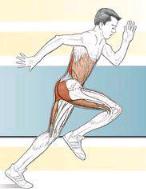
CHAPTER 1
THE EVOLUTION OF THE HUMAN RUNNER
Haile Gebrselassie once said, “Without running there is no life.” The sheer joy expressed by Gebrselassie about his running is shared by millions around the globe. It surpasses language and cultural barriers, so a stranger abroad can invariably change into shorts and running shoes, find a trail, and meet kindred spirits enjoying life with the same enthusiasm. Running ranks highly among ways of combining pleasure with health promotion. As civilization has progressed, the need for people to run for survival has been tempered by the development of new skills so that the average human can now enjoy leisure time in a way that the majority of our ancestors would have found at the very least impractical, and quite possibly fatal. Although the ability to run was once quite literally a matter of life and death, the social development of the biped means that running has taken on a new character. It has become a conduit for the expression of human competition, of socialization, and of scientific experiment and development. It is probably the most natural form of exercise that does not involve aggressive or antisocial techniques or require expensive equipment. Any able-bodied human should be able to enjoy it.
Although the first purpose of this book is to enable you to understand the function of the anatomy of the body involved in running, the greater aim is to add training exercises and techniques that any runner can use to enhance his or her own sporting satisfaction. Running better does not necessarily involve running faster. If this book allows you to complete your runs in a more relaxed and less distressed manner than previously, and if following the exercise schedules reduces the incidence of pain and injury, then that is surely a positive gain. Not only will you be able to look back on your previous run with pleasure, but the anticipation of the next is likely to be far more positive as well.
In the past 40 years, an entire industry has developed around the sport, although the practice of running stretches back for many thousands of years. Clothing and shoes, diet and physiology, and the surfaces on which and the environment in which we run have all undergone research, experimentation, and review in this short epoch. In much the same way that the coming of the “Iron Road” of railways some 200 years ago changed the way in which we lived, so running has entered the everyday lives of millions of people and with very few exceptions has benefited the majority. Although it is impossible to completely ignore the other interlinked factors that make a runner what he or she is, this chapter traces the evolution of anatomy as it affects the runner, researches the characteristics and physique that produce success, and even tries to predict the makeup of the perfect runner, if such an individual could ever exist. In the past, many learned authors have speculated on the ultimate running performance, only to find it bettered. We would like to envisage the makeup of the athlete who could produce that unbreakable record, and then in the subsequent chapters guide you toward making and breaking that goal.
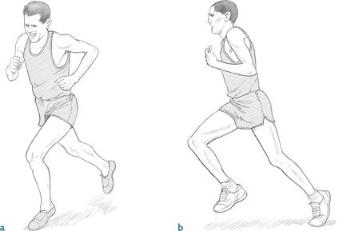
Evolution of Running
The running skills of humans evolved as a response to predators who also vied with humans for sustenance. This was before our brains developed and we were able to think our way out of trouble. Those who could run the fastest not only got to the food first and had the biggest and most nutritious portions, but also were able to leave the quickest if danger appeared. Those who were unable to run were invariably the first to fall by the wayside because of an inability to obtain sufficient food, or because they lacked time to eat it, or because they fell victim to predators as a result of their lack of mobility.
It might be interesting to conjecture how fast our predecessors would have been able to run if they had not developed their brains and learned more cunning ways to avoid danger. However, the concurrent use of brain skills to manufacture weapons with which to hunt meant that our forebears had to rely less on pure speed for survival, and the ability to run flat out became less of a necessity and more of a virtue. The communities in those times were largely tribal, and chiefs had skills over and above the majority, so the ability to run fast would figure strongly as he or she sought respect, much of which could be gained through competition, which could include running races. Eventually, the survivors passed on the genetic makeup that produced speedy legs to their offspring, and because the need to be able to run at speed was still required, faster runners continued to evolve. In those times, pure upper-body strength was generally needed more than litheness, so those peoples for whom running had become a less important element of their life skills would probably not have looked much like competitive runners as we see them today (figure 1.1). These were people who spent their lives in physical endeavor, so they probably had a physique equivalent to the modern gym attendee, who regularly works out on a broad program of exercises but avoids specific sport-related repetition.
At some time, running evolved to have other uses. Although horses were the principal carriers of messages, sometimes people could be more efficient. Some 2,500 years ago, Pheidippides ran from Marathon to Athens to deliver news of victory in battle against the invading Persian army, though he did little to promote it as a leisure activity, dropping dead as he finished the run. Today, people and horses have an annual organized race in Wales to test the theory about which is the faster species. These early civilizations were able to enjoy sports, and one development was the organized Olympic Games, which honored the Greek gods and included running races over various distances. They lasted until AD 394 but were eventually banned because of their pagan origins.
Until relatively recent times, women did not run anywhere near as much as men, partly because they were not participating in the same kinds of foraging and defense activities; rather, they were expected to produce children, usually the more the better and one after another. Time was then used to feed and teach these offspring the basic skills needed for survival until the mature males took over for the more advanced tutoring. The ability to run might still have been necessary to avoid danger, although advances in methods of transportation would have lessened the need even for this.
Figure 1.1 Comparing the physical build of (a) a runner from the past with (b) a contemporary runner.
Hard evidence of both competitive and noncompetitive running between Roman times and the Middle Ages is hard to come by. It may well have happened, but it was not recorded by the scribes of the time who had far more important items to chronicle, so it has become lost in the mists of history. Once they had established the basics for living, people from those times were more concerned with territorial gain and religion than events that would have done little to enhance their lives. If any time was given to leisure pursuit, running would have had to compete with throwing and wrestling events, weapon skills, and the inevitable drinking competitions, among many others.
Some 14th-century texts contain references to running races held across open country, and there is evidence to suggest that competition developed from games based on hunting. In the 18th century, a new sport had emerged in which two or more horse riders would race each other to a distant church steeple. By the 19th century, simple foot races called steeplechases were organized along the same lines. These races were promoted further by the fee-paying schools and universities in the United Kingdom, who also ran “paper chases” in which a “hare” would leave a trail of paper for the “hounds” to follow. This led to the formation of the amateur Harrier Clubs for road and cross-country running that still exist today. Once again women played no part in this social convention, decreeing that it was inappropriate and demeaning to the upper classes, and the poorer majority were far too busy simply trying to survive.
During the second half of the 18th century, walking competitions between gentlemen’s servants gave way to men racing against time over longer distances. One of the more popular goals involved covering at least 100 miles in less than 24 hours. Those who achieve this are still called centurions in a flashback to Roman times. Other contests involved covering one mile in each of 1,000 successive hours. (This is more than 40 straight days!) The early 19th century saw the return of races between men, and town-to-town events, accompanied by heavy gambling, for a while became the most popular sport in England.
The winners of these races were those who adapted to the generally horrific environmental circumstances and lack of nutritional variety that existed at the time. Disease was rife, life expectancy was short, and diet relied in the main on whatever seasonal local supplies were available. Any training for the events as recognized in the 21st century was nonexistent, and the pedestrians would consume large quantities of meat, often raw, and alcohol, frequently in large quantities, before and during competition. In fact, training specifically for a race was considered to hinder performance because it might exhaust their energies. It was not that they were unfit, as the competitors invariably came from the laboring masses for whom a 12-hour day of physical toil was the norm, rather than from the much smaller ranks of those with sedentary jobs.
The establishment of the modern Olympic Games was of little interest to the majority of the world’s population, who had no means of entering
or enjoying competition, even if they knew of it; until well into the 20th century, the Games remained the prerogative of the rich and otherwise idle, who disdained most preparation for the events. Some pioneers such as Paavo Nurmi and Hannes Kolehmainen put thought into how their racing performances could be improved and utilized the most basic sport science, but it was only in the second half of the 20th century that disciplines that could be recognized as scientific were applied to running, such as those done by Arthur Lydiard. Lydiard was different: He trained alongside his protégés, asking them to do no more or fewer miles than he, and led them through a regime that intrigued the world. It was LSD—long slow distance—for everyone. Percy Cerutty used new techniques including sandhill running to win his students Olympic gold medals.
Running and science have had a symbiotic relationship because runners have become unintentional guinea pigs for physiological testing. When statistics have demonstrated that runners have veered away from some expected normal values, scientists have been able to use the results to explain the physiology of the heart, circulation, lungs, and other organs. Extrapolation of the findings has led to progress in many medical specialities. Intertwined with this have been the advances in dietary knowledge. In basic terms it might prevent a runner from the consequences of eating a large meal before exercise, and at its most sophisticated, elite athletes often have an integral dietary program prepared as part of a whole season of competition. Medicine could never have developed to the extent it has without the participation of the running community any more than runners could have become faster without sport science.
Running hit the headlines as a leisure activity for the general populace only after the mass publicity and television coverage that accompanied the New York and London marathons in the late 1970s. In these races there was a large number of newcomers to the sport in which the emphasis on speed was replaced by jogging at little more than walking pace. It would be an exaggeration to call the majority of them competitors. This development was not only tolerated but also even encouraged as the races became a mixture between the opportunity to raise money for charitable causes and fancy dress competitions.
In terms of speed, the successful runners were those who had prepared themselves best both physically and mentally. It was noted that faster runners rarely carried excess weight, and the perception of running as a health benefit grew as parallel advances in science demonstrated that obese and sedentary people had a lower life expectancy. Race winners had usually run many miles in training before competition, although grossly excessive mileage, as in the case of British 10,000-meter world-record holder Dave Bedford, could lead to painful and career-ending injuries. It became understood that running well was not simply about quantity, but the quality of the mileage was also a decisive factor, so multiple theories of optimal training regimes abounded, none of which has yet been shown to be superior to the others in all circumstances.
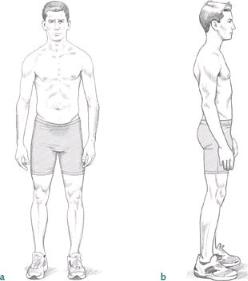
Physiology of Runners
As more nations entered competition, ethnic variations in ability appeared. Afro-Caribbean athletes showed themselves to be the preeminent sprinters, whereas those from higher altitudes became the fastest endurance athletes, their bodies having adapted to a decreased oxygen concentration in inhaled air. The act of sprinting fast uses nearly all the muscles of the body during the event. A still photograph of the top exponents at full speed will show taut neck muscles and bulging eyeballs, not exactly the first areas to be considered when running! But if these muscles, in whatever small way, are used to increase speed, then these muscles must be trained for the event in exactly the same way as the massive thighs that provide the explosive power and high knee lift more usually associated with sprinting. Conversely, the best long-distance runners became almost pitifully thin, especially in the largely underused upper limbs, as it was realized that the less weight that they carried, the less energy would be expended in moving their bodies efficiently for mile after mile. However, one enemy of the distance runner is dehydration, a catalyst for both illness and injury, so adaptation to conserve and absorb water, especially in warmer climates, was at odds with the perceived need to be emaciated. Low fat stores, thin and sinewy muscles, and a low mass of other soft body tissues are not conducive to transporting large volumes of fluid internally during a run. The core temperature of the body needs to remain as close as possible to 98.6 degrees F (37 degrees C), not only to work most efficiently, but also, and more important, to survive. The energy burned when running produces heat, and it is by the mechanism of sweating that the core temperature is maintained. If the body is dehydrated, this cannot occur, so at worst a life-threatening hyperthermia may develop as the body temperature rapidly soars. This may help to explain why some winners of distance races can be comparatively well built, because they are able to store larger quantities of fluid to provide for the event. Science shows that performance deteriorates precipitously as the runner becomes overheated and dehydrated, so as with the tortoise and the hare, the winner may be the runner who has prepared best for the whole distance and not relied on pure speed to win the day.
Transposing the body types and events quickly demonstrates the impracticality of either entering the other’s competition. The sprinter would quickly tire as he carried his comparatively heavy body for more than a few hundred meters, even if he could store sufficient fluid, whereas the undermuscled distance runner would immediately be at a disadvantage in an event requiring brute strength and power. These are extreme examples, but in general most events attract successful competitors who have comparatively similar physiques. It is interesting to consider how rare it is that more than one world record is held by a single competitor; where it is, the events tend to require very similar speeds and skills. Thus, Michael Johnson simultaneously held the 200and 400-meter records, and Haile Gebrselassie the 5K and 10K, but for success at the highest level, the Olympics and world championships, very few runners enjoy the luxury of being able to prepare for, let alone win, more than one event.
Women have been latecomers to the running scene. Races for women longer than 400 meters were not introduced to the Olympic Games until 1964 because it was considered, without any scientific proof, that they might suffer some unspoken medical ailment if they were to “strain” themselves. Once it was shown that they thrived in competition, their advancement was so rapid that by 1984 they were allowed their very own marathon at the Los Angeles Olympics. Anatomically, women are generally disadvantaged compared to their male counterparts (compare figures 1.2 and 1.3), especially where the long, light levers that make up the lower limbs are concerned, but physiologically they are in some ways better prepared, especially for ultradistance running. Because they have proportionately more fat as a percentage of body weight compared to their male counterparts, they have greater reserves of energy and stored fluid to call on, although it may take days rather than hours of competition for this to emerge. It is in ultradistance racing that the performance of women comes closest to men. With increasing distance, the difference between the sexes in statistical terms in time run becomes less and less marked, so it may well be that one day a woman will win an open race purely as a result of better physiological efficiency. Women are disadvantaged by relatively short thighs, which become exaggerated by their wider hips and bring the pelvis closer to the ground, resulting in a reduction of stride length. Stride length is perhaps the factor with the most effect on the speed of running. Although the fastest runners take no more than double the number of strides of the slowest over a given unit of time, their stride length may be up to four times greater.
Although the abdomen of the male largely consists of the intestinal organs, which are involved in fluid balance and retention, that of the woman also has to accommodate the relatively bulky uterus and reproductive organs, limiting the volume available for the bowels. These are not large differences, perhaps even only 1 percent or 2 percent, but they also determine the differences between the relative athletic performances of the two sexes. Add to that breasts and the limitation of smaller chests and lung capacity, as well as smaller feet, which mean that part of the mechanical leverage of propulsion is reduced, further handicapping women when pure speed is the consideration. However, as the male distance runners have shown, small size is not necessarily a disadvantage, and the physiological differences that become more marked in favor of women with greater time and distance run may ultimately lead to an equalization between the sexes over the longest distances.
Figure 1.2 Male runner: (a) front view; (b) side view.
